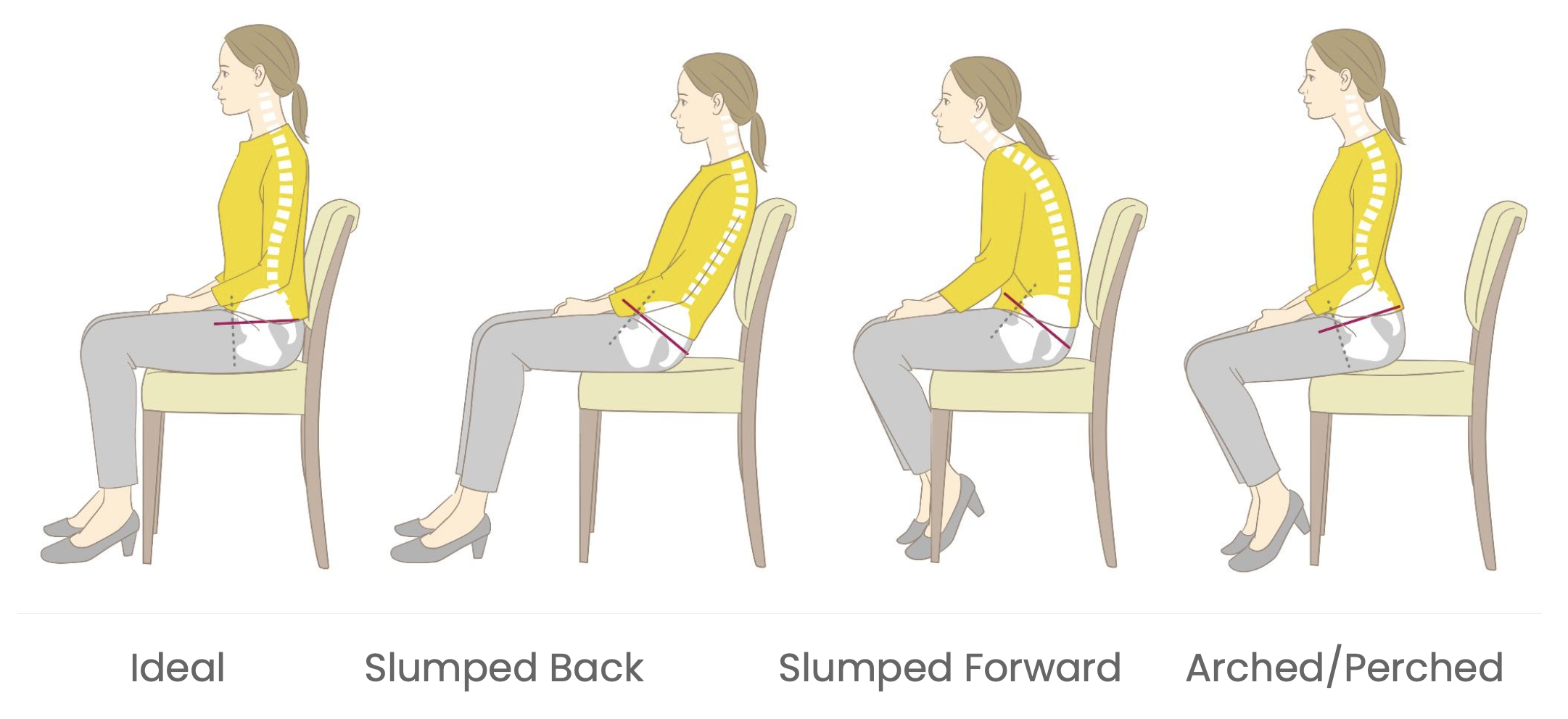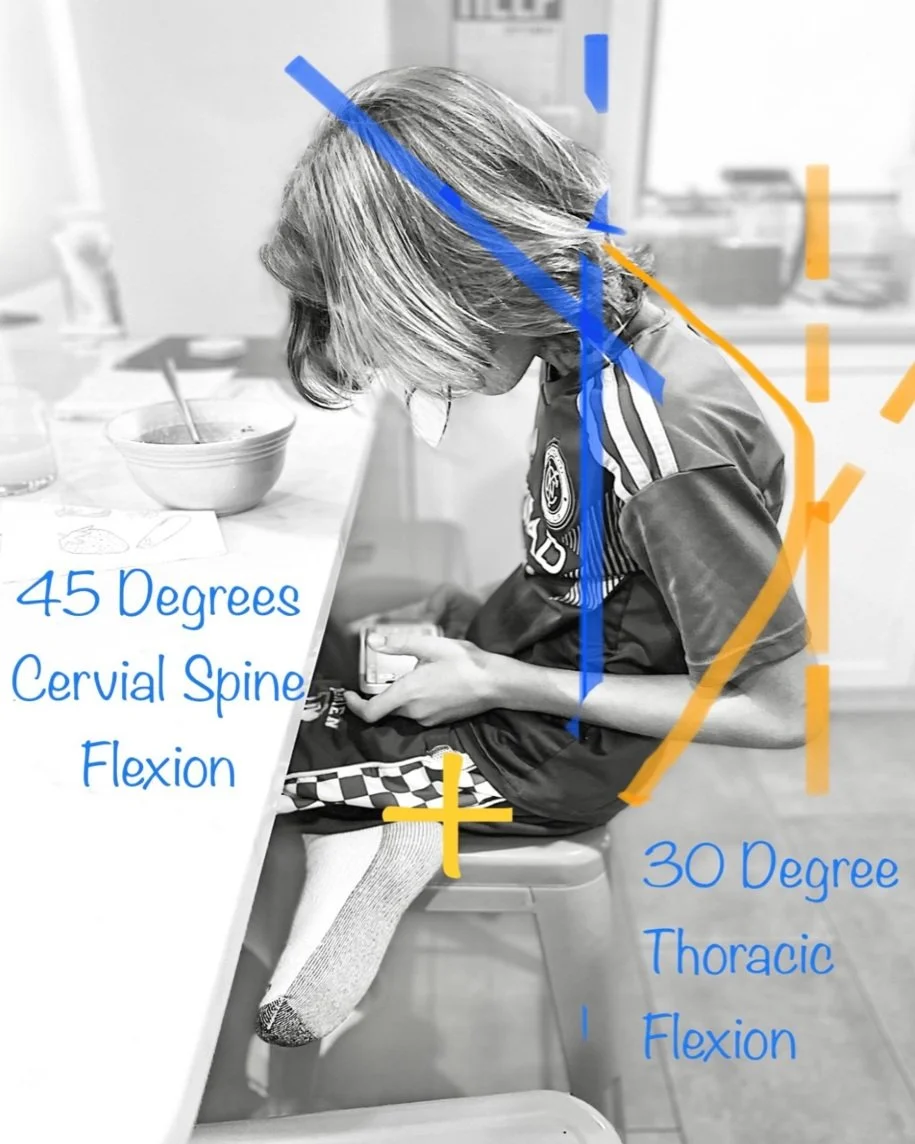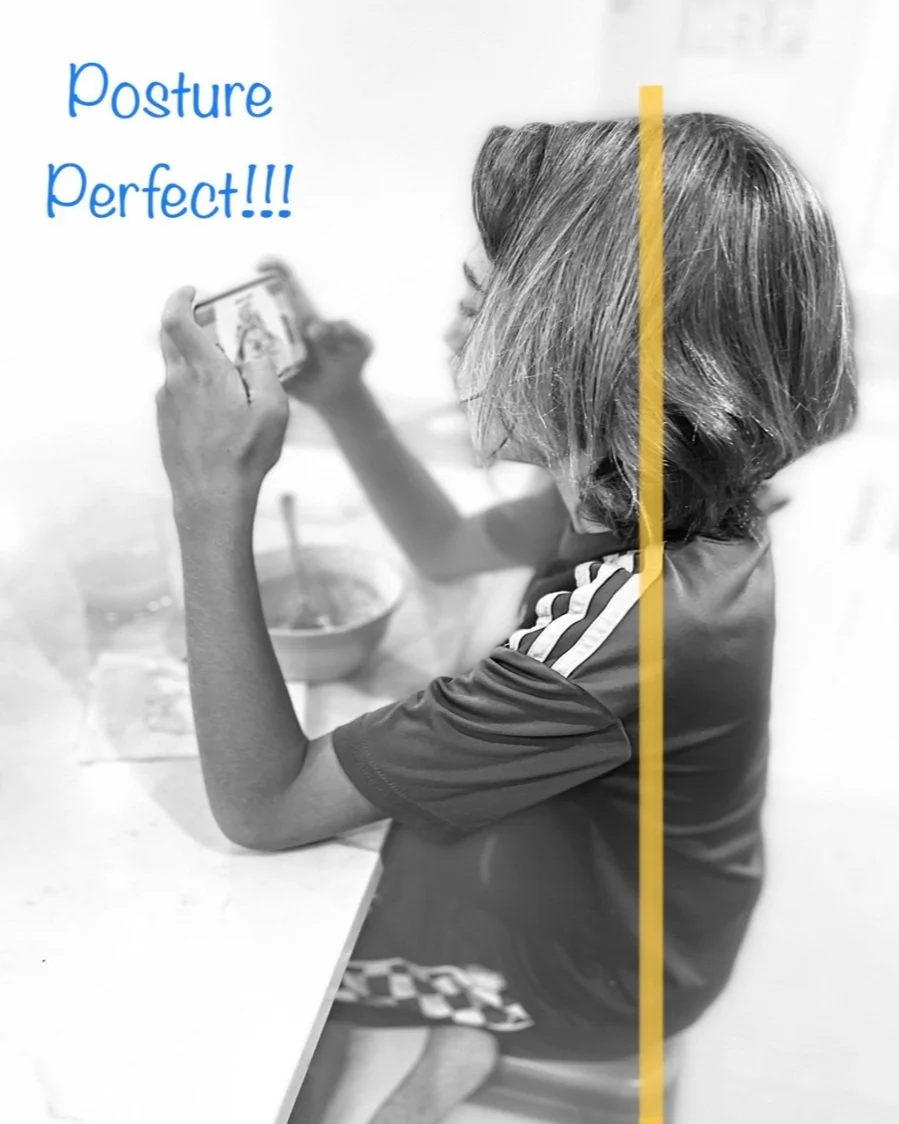Posture Perfect
While looking your best may be one of the most visible benefits of optimal postural alignment there are many other ways standing and sitting “up straight” benefits our body and mind.
Benefits of Good Postural Alignment
Improved Breathing
Improved Digestion
Pain Prevention
Improved Mobility of Joints and Spine
Improved Circulation
Improved Mood
Improved Concentration
Improved Athletic Performance
Improved Appearance!
Unfortunately just as much as optimal postural alignment benefits our body and mind, non-optimal or impaired posture has many negative effects.
Impaired Posture places abnormal forces on the muscles and spine often for prolonged periods of time. This can result in pain, limited range of motion, reduced flexibility, loss of function and impaired athletic ability.
Negative Impacts of Impaired Posture
Soreness and Pain Neck & Back
Fatigue
Negative Feelings
Impaired Breathing
Reduced Range of Motion and Flexibility
Inhibited Athletic Performance
What is Optimal Postural Alignment?
Our spine has a natural S-Curve that is concave ( at the neck and low back and convex ) at the thoracic spine, the area of the spine with rib attachments. The entire spine sits on the bones of the pelvis and the pelvis rests on top of the hip joints, knees and ankles.
Ideally if we imagine a line dropping straight down our ears would be over our shoulders, our shoulders in line with our hips, our hips over our ankles. We would have a neutral lumbar and pelvic alignment, not too arched, not too flat. Our knees are straight, not hyperextended, feet and ankles in “talur neutral,” feet not too flat or too arched.
An easy way to check your posture is to stand against a wall or door.
Hips and mid back against the wall
Back of your head is against the wall
Shoulders & shoulder blades back and down
Knees straight and ankles under hips
There should be a space between the wall and your low back and neck.
*If you are unable to reach your head to the wall without crunching your neck don’t force it! This is where your body is today. A starting point on your postural journey.
Sitting
We need to sit throughout the day to work, learn, drive and for recreation. How we sit is just as important to our wellbeing as how we stand. Ideal Sitting Points
Feet Flat on Ground
Knees at 90 degrees
Hips All the way back in chair
Low back supported by chair
Pelvis neutral
Shoulders and Head aligned with hips
There are a plethora of options regarding seating at work stations, dining tables and places of relaxation. Often it is not the chair, couch or stool we are sitting on but rather HOW we are sitting on it that makes all the difference. Often It is not our chair that is the issue, rather it is how we are using it.
While this work from home set up is not in any way ideal, how we sit while using it can be improved in an instant.
Ideal postural alignment is often not attainable due to structural variations in how our skeletons are put together. Injuries, systemic diseases such as osteoarthritis and osteoporosis, and medical conditions can all impact our structural alignment and posture.
It is important to seek the advice of a trained medical professional to establish a postural re-education plan that works for your body. We are all different. Seeking medical advice is especially important if you are experiencing pain in the spine or joints, experiencing numbness or tingling in your arms or leg, or any kind of strength loss.
Physical Therapists are specially trained to assess posture, alignment, quality of movement, and biomechanics. We develop individualized plans to improve strength, flexibility and reprogram neuromuscular pathways to optimize posture.
You do NOT have to wait to be in pain to seek out the advice of a physical therapist to improve your posture, biomechanics and optimize your daily function!
Pain and Posture
Pain is one of the most common reasons an individual may seek medical attention. Each day in the United States 10-20% of the adult population is experiencing neck and/or back pain. That is a LOT of people!
Pain in the neck and back can impact daily activities, our ability to work, participation in activities we enjoy, and our overall quality of life. It is also a massive pain for our wallets! Personal spending on low back and neck pain accounts for the third highest amount of health care spending in the United States, according to an analysis by JAMA (Journal of American Medical Association). Only spending on diabetes and ischemic heart disease costs Americans more!
Postural Dysfunction is one of the most common causes of back and neck
pain. It especially affects women and those who work in offices. The good news? It is also one of the most preventable.
What is Postural Dysfunction?
It is neck or back pain that limits functional ability due to abnormal postural alignment, generally without structural abnormality on diagnostic imaging. Quite simply a pain in the neck or back caused by how we sit, stand, and move throughout the day.
Postural Dysfunction Causes
Poor alignment of the spine can lead to muscle imbalances that result in abnormal forces on our musculoskeletal system and result in pain, loss of motion and lack of functional ability.
Muscle Imbalances
Upper Cross Syndrome
Forward Head Posture
Weak Deep Neck Flexors
Weak upper back muscles
Tight Pectoral, chest, Muscles
Tight Upper Trapezius and Levator Scapula, Neck, Muscles
Lower Cross Syndrome
Slumped Sitting
Weak Abdominals
Weak Gluteal Musculature
Tight Lower Back Musculature
Tight Hip Flexors (front of hips)
Preventing Painful Postural Dysfunction
Be Mindful
Increase awareness of your posture throughout the day. Try avoid habitual non-optimal postures.
Slumping, backwards or to side
Forward Head and Rounded shoulders
Sway Back Posture, hips pressed forward, back arched Increased Lordosis, arched back, buttock tilted back
Maintain postural alignment while using phones and other devices
Exercise Regularly
Regular exercise reduces neck and back pain, depression and improves daily function and reduces disability according to multiple studies. Walking and strengthening programs are the most effective at reducing neck and back pain in office workers.
Walking 30 minutes/day benefits much more than just your posture. Walking regularly at a brisk pace reduces your risk of heart attack, stroke, cancer, diabetes, weight gain, eases arthritis pain, reduces cravings for sugary snacks, boosts immune function, improves memory and improves healing time.
WOW! I’m heading out for a walk. Right now.
Take Breaks to Move and Breathe
There is no hard and fast rule regarding breaks. It is generally recommended we sit no longer than 30 minutes without a standing break as a goal. Breaks do not have to be long. 30-60 seconds of movement can do wonders. Stand up, take a deep breath, and move your body.
Think you cannot take a break because you have too much to do? Consider the lost productivity experienced from pain, taking time out of your day for medical appointments!
Some simple strategies to create more movement in your day include setting a movement timer, taking calls standing and or walking, and varying your workstation position throughout the day.
Set up your Workstation for Success by creating a dedicated work space that fits your body.
Avoiding the Dreaded Text Neck
Devices such as cellphones, tablets and computers are integral to daily life and work and create challenges on our posture and musculoskeletal system.
It is critically important to our bodies and minds that we use these devices in a healthy way.
Just a few degrees of forward head posture while we look down at our phone or computer can place a huge amount of stress on the musculoskeletal system that supports the weight of our head.
“The human head weighs 8lbs.” We all know this from the movie Jerry Maguire, but that is not the whole story. It depends where the head is in relation to the rest of the body.
Neutral Alignment: ~10-12lbs
15 degrees forward: ~30lbs
30 degrees forward: ~40lbs
45 degrees forward: ~50lbs
60 degrees forward: ~60lbs
Can you imagine holding a 40-60lb weight up all day! Or even for 15-20 min?
Not surprisingly forward head posture significantly increases the likelihood of developing neck and upper back pain. These muscles need a break! Getting the head in good alignment is incredibly important.
Do NOT Bow Down to Your Device!
It is so easy to fall into postural alignment that significantly impacts our body and mind. Mindfully using our devices and raising them to us has a massive impact.
Workstation Modification
A recent study of faculty members at a Canadian University who pivoted to work from home during the COVID-19 pandemic, often using workstations that were not at all ideal, has concluded that there is a significant correlation between poorly ergonomically designed workstations and musculoskeletal pain. The study also concluded that women are at a significantly higher risk of developing musculoskeletal pain when using poorly designed workstations. Incorrect seat height and monitor distance are significant predictors of musculoskeletal pain.
Sitting Workstations: Alignment from the Ground Up.
Feet Flat on floor
Back supported in chair
Shoulders in line with hips
Neck in line over shoulders
Desk at elbow height, adjust chair height or desk height
Keyboard and Mouse allow elbow to stay in line under shoulder
Monitor straight ahead and height slightly below eye level.
Lower monitor more if you wear
progressives!
Laptops and Chromebooks
Laptops and chromebooks are light, portable, and convenient, but were not designed for prolonged use. They present ergonomic and postural alignment challenges. A few simple changes and make an enormous difference when working on a laptop or similar device.
Set up a dedicated work space
Look straight at monitor
Raise your monitor with a laptop stand
Invest in wireless mouse and keyboard
Elbows are at a 90 degrees angle
Do not rest wrists on desk edge
Avoid working on couch, bed or floor
Maintain good sitting alignment and use back support.
Avoid stools and perching on the edge of the seat.
Standing Desks
Varying working positions throughout the day can have many benefits. Standing desks provide increased caloric expenditure and a break from sitting. They also can place increased pressure on the wrists, and lower legs so a good set up is key.
Desk height approximately at elbow height
Keyboard and mouse allow elbow to be aligned under shoulder
Monitor an arms length from body
Foot rest and soft mat for low back support
Periodic sit breaks on ergonomic seat
Vary position throughout day, set a timer
For more detailed information on workstation
ergonomics OSHA, Occupational Health and Safety Administration, has a
comprehensive checklist to assess your current workstation and guide for
new purchases. Both are accessible here on their website.
The content presented is for general education only. It does not replace the care of physical therapists or other health care professionals and in no way is to be construed or substituted as physical therapy or other medical advice. This program may not be appropriate for your specific situation. Get approval and guidance from your own healthcare provider before beginning. Perform at your own risk. Do not use this content to self diagnose or self treat any health, medical or physical condition.
You agree to hold harmless Concierge Physical Therapy, PLLC for any and all losses, injuries or damages resulting from any and all claims that arise from your use or misuse of this content. The company cannot guarantee the outcome of educational content or recommendations on the company website, social media, blog, or email series. Concierge Physical Therapy, PLLC’s comments are expressions of opinions only.
Works Cited
Dieleman JL, Baral R, Birger M, Bui AL, Bulchis A, Chapin A, Hamavid H, Horst C, Johnson EK, Joseph J, Lavado R, Lomsadze L, Reynolds A, Squires E, Campbell M, DeCenso B, Dicker D, Flaxman AD, Gabert R, Highfill T, Naghavi M, Nightingale N, Templin T, Tobias MI, Vos T, Murray CJ. US Spending on Personal Health Care and Public Health, 1996-2013. JAMA. 2016 Dec 27;316(24):2627-2646. doi: 10.1001/jama.2016.16885. PMID: 28027366; PMCID: PMC5551483. https://pubmed.ncbi.nlm.nih.gov/28027366/
Louw S, Makwela S, Manas L, Meyer L, Terblanche D, Brink Y. Effectiveness of exercise in office workers with neck pain: A systematic review and meta-analysis. S Afr J Physiother. 2017 Nov 28;73(1):392. doi:
10.4102/sajp.v73i1.392. PMID: 30135909; PMCID: PMC6093121.
https://www.ncbi.nlm.nih.gov/pmc/articles/PMC6093121/
MacLean KFE, Neyedli HF, Dewis C, Frayne RJ. The role of at home workstation ergonomics and gender on musculoskeletal pain. Work. 2022;71(2):309-318. doi: 10.3233/WOR-210692. PMID: 35095004. https://safetyservices.ucdavis.edu/units/occupational-health/ergonomics/office-computer/sit-stand
https://www.choosept.com/didyouknow/detail/low-back-neck-pain-cost-americans-billions-in-heal
https://www.ors.od.nih.gov/sr/dohs/Documents/Computer%20Workstation%20Ergonomics%20Self%20As sessment%20Checklist.pdf
https://pubmed.ncbi.nlm.nih.gov/27598552/ ]https://www.ncbi.nlm.nih.gov/pmc/articles/PMC4984813/ https://www.ncbi.nlm.nih.gov/pmc/articles/PMC5440123/













